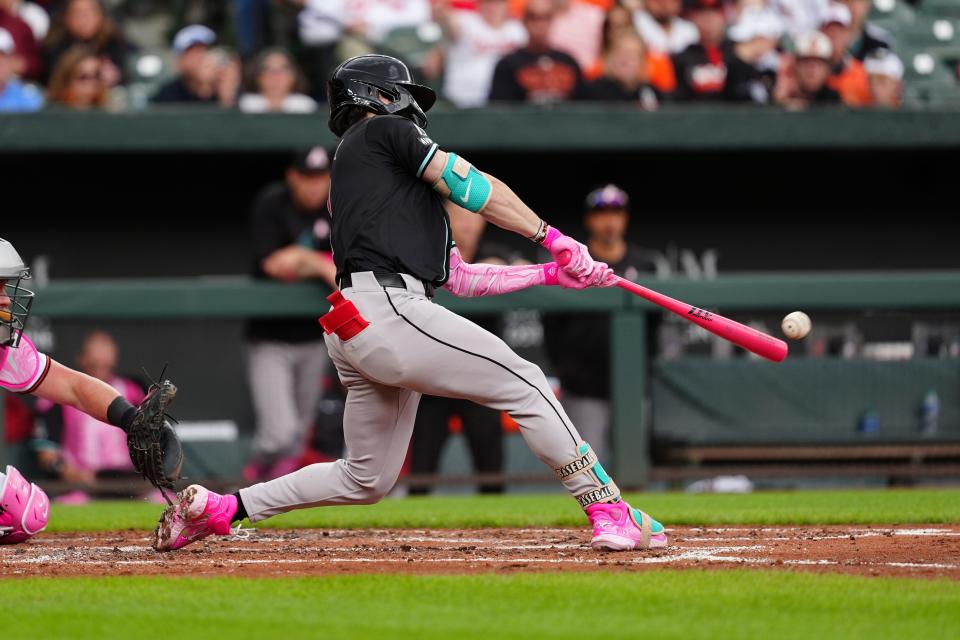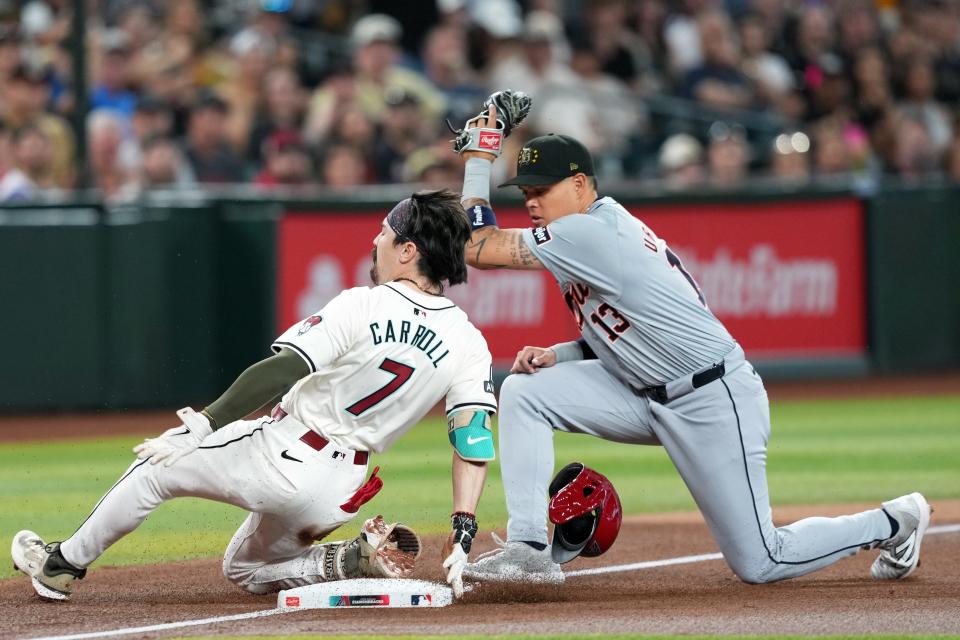Has Diamondbacks' Corbin Carroll fallen victim to the dreaded sophomore slump?
LOS ANGELES — As the baseball season enters its eighth week, the Diamondbacks’ Corbin Carroll remains one of the least productive hitters in the majors. His at-bats have been better in recent days, but his slow start has been a stunning reversal for a player who took the league by storm last year.
It has led some to conclude Carroll has fallen victim to an age-old baseball malady: the sophomore slump. After Carroll performed as a rookie, the league has figured him out, identifying his weaknesses and ruthlessly exploiting them. Or so the theory goes.
An argument can be made as to whether the sophomore slump is more real than imaginary. The same can be said as to whether the phenomenon would even apply specifically to Carroll’s experience. Either way, his lack of productivity at least partially explains the Diamondbacks’ inconsistent offense, and, by extension, the club’s uneven start to the season.
Entering Monday, Carroll had just a .191 average with a .553 OPS; the former is down close to 100 points from his National League Rookie of the Year campaign, the latter down more than 300 points.

The idea of a Year 2 slump makes sense. Armed with a full season’s worth of information, the league makes adjustments to the second-year player, forcing him to find other ways to produce.
“Guys don’t come up as unknowns anymore, but when there’s firsthand knowledge — when you’re facing a guy consistently — there’s a difference in the second, third and fourth time,” Diamondbacks bench coach Jeff Banister said. “The adjustments are hard at this level. It’s a constant process, especially as a hitter.”
Banister is right about players arriving from the minor leagues not just with reputations, but with data and video to support them. Clubs have easy access to, say, a top prospect’s results against certain pitch types in Triple-A. They can also quickly cue up video of those pitches to lay eyes on a hitter’s swing.
But pitchers might not immediately trust that data — or think it applies to them. Breaking balls a hitter sees in the minor leagues might be significantly inferior to those he encounters in the majors. And a pitcher’s ego might lead him not to trust the data even if it were sound.
“Someone might be like, ‘I’ll see if he can hit my stuff,’” Diamondbacks closer Paul Sewald said. “You might think, ‘I don’t care if he hits high fastballs. He hasn’t seen my high fastball.’”
All of which could support the idea that a hitter needs to go around the league multiple times before wholesale adjustments are made to the way teams attack him. But there are those who believe that sort of thinking is overblown.
“Does (Carroll) get more attention coming out of what happened last year? Yes,” Diamondbacks General Manager Mike Hazen said. “But I think he was getting that attention last year, too. I think he was one of the shining stars on our team. Maybe for the first couple of months (of 2023) he got challenged a little aggressively, but especially by the second half and when the playoffs rolled around, people were well aware of what he could do. I don’t think (the sophomore slump) is a thing.”
Diamondbacks pitching strategist Dan Haren shares Hazen’s viewpoint. Haren thinks the league is capable of figuring hitters out much faster than year over year, and he said different plans of attack are constantly being formulated for the same hitters based on how they’re doing immediately before a series.
“I think that if there’s a specific weakness, it can be exposed in a matter of 30 or 40 at-bats,” said Haren, who helps devise game plans for Diamondbacks’ starting pitchers. “For the best hitters in baseball, the more recent the struggle, the more you trust it. If a really good player is struggling with something at that particular time, that’s going to be where they’re going to attack him.
“Teams are gathering data as the season goes along and they’re making adjustments to pitch plans; it could be week in, week out or it could be every two or three weeks. I’ve seen hitters change throughout the course of the year: They could be covering in but not covering away and then next time we see them, they’re not covering in but covering away. That’s the flow of the season.”
'Nowhere to go but down'

Then there is the possibility the sophomore slump exists mostly as a sort of narrative device, an idea proffered by Baseball Prospectus Managing Editor Patrick Dubuque. For a story he wrote in April, Dubuque looked at a recent 30-plus year sample of players and found that production mostly does decrease in Year 2, but he concluded the drop-off can be attributed largely to luck.
That is, a player had to have enough things go right in his first year to even be considered a candidate to slump in his second season, and often his luck changes enough to explain the decline.
“You can always come up with examples where a player was best as a rookie and never got there again, but most of the time it’s just that variation between peripheral and production,” Dubuque said. “And often case there is nowhere to go but down.
“Baseball is the most random sport in the world. It has the most luck and the most undefinable chaos in it. And people cannot handle that. So we’ve got to ascribe meaning to it and find these patterns. So the sophomore slump is a narrative force. It exists partially because we think it does.”
Tickets cost too much? DBacks bring back popular summer ticket deal
The sophomore slump can also be viewed through a soft science lens. Sewald mentioned what he saw Mariners outfielder Julio Rodriguez go through early last season when they were teammates in Seattle. Sewald remembers Rodriguez appearing baffled by his slow start to the year, seemingly carrying a “giant weight on his shoulders.” Sewald believes first-year success can create expectations that are difficult to meet.
“We as fans and writers or whoever, we want to see you get continuously better, which is not necessarily fair,” Sewald said. “You might have peaked your rookie year because your peak was so extremely high. And we all ask for linear development of success and that’s just not always how it works.”
That experience seems to track closely with what Carroll has gone through. Another point many onlookers have raised is the fact that Carroll has never struggled to perform on a baseball field in his professional career — perhaps in his life — making an already difficult experience even more difficult.
As for the hard data on Carroll’s season, there is not much to suggest he is getting pitched all that differently than last year. What has happened is he is struggling to handle pitches he would occasionally hit last year, namely hard stuff in.
Carroll said he inadvertently made his bat path too flat, something he has been trying to adjust over the past month. He made small tweaks to his swing in the offseason in an attempt to handle fastballs and cutters better than he did last year. A source with another club said data confirms that thinking.
“There is significant changes in his vertical angle of attack from 2023 to 2024,” the source said. “Last year, he was below average. Now, he’s well below average.”
Even that could be twisted to fit the sophomore slump narrative: Were Carroll more experienced, he might have known better than to try to make that sort of change.
“All players are guilty of it,” Diamondbacks hitting coach Joe Mather said. “Trying to cover too much of a hole, losing maybe what you’ve always done great. We can all fall into that, but especially younger players. He’s just having to work through it for the first time at this level.”
And most everyone around baseball, whether they are affiliated with the Diamondbacks or not, believes Carroll will, in fact, work through it eventually.
“He’s working his (butt) off,” Hazen said. “Obviously, we know how much he cares. This will get figured out.”
Said Sewald: “If you have one-fifth of a bad season and four-fifths of a good season, we’re going to be talking in October about how Corbin has taken that step to be one of the Top 20 players in baseball. We’ll forget that he had a bad start.”
This article originally appeared on Arizona Republic: Has Corbin Carroll fallen victim to dreaded sophomore slump?

